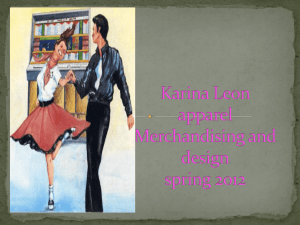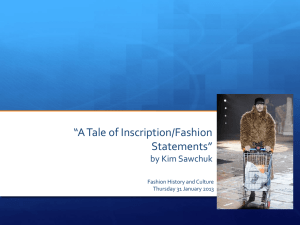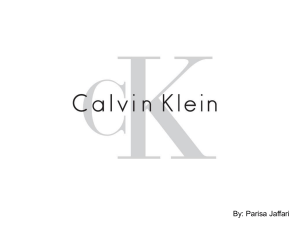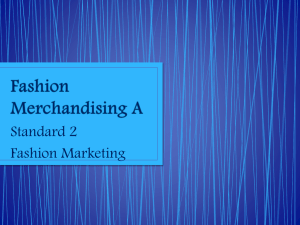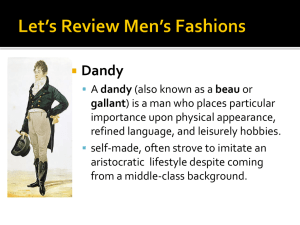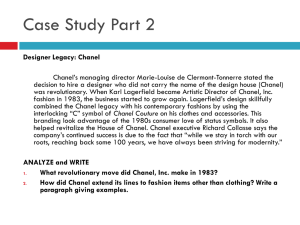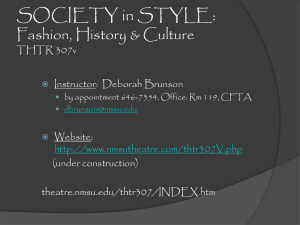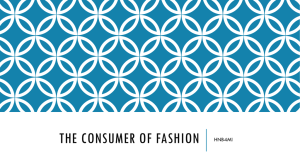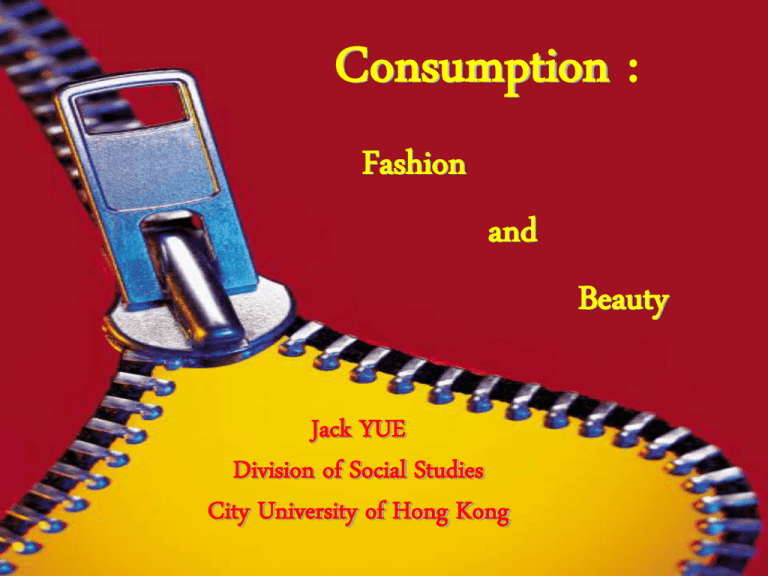
Consumption :
Fashion
and
Beauty
Jack YUE
Division of Social Studies
City University of Hong Kong
The Theme
Some (mis-)conceptions
What is consumption(-ism)
History of consumption
Context and system: shopping
Fashion/Beauty: the trend
Fashion/Beauty: the meanings
Appreciation & Critique
Some (Mis-)Conceptions
All about money
Meaningless hedonists
Subsidiary & residual
Not-for-the-youth
Decadence (materialism)
Superficiality
(fetishism of commodities)
“Consumption”
In 1928, André Siegfried, a Frenchman who had visited the
United States four times since the beginning of the century,
commented that a "new society" had come into being, in which
Americans considered their "standard of living" a "sacred
acquisition, which they will defend at any price." In the Atlantic
Monthly, the journalist Samuel Straus called this new society
"consumptionism" and identified advertising and motion
pictures as its distinctive forms of communication. In
Muncie, the Lynds found that new leisure activities and a new
emphasis on consumption had supplanted politics as the focus
of public concern. Elections were no longer "lively centers" of
public attention as in the nineteenth century and voter turnout
had fallen dramatically. National statistics bore out their point;
the turnout of eligible voters, over 80 percent in 1896, had
dropped to less than half of those registered by 1924. There
were many reasons for this decline, including the consolidation
of one-party politics in the South, the enfranchisement of
women (who for many years voted in lower numbers than men),
and the long period of Republican dominance in national
elections. But the consumerist shift from public to private
concerns undoubtedly played a part. "The American citizen's
first importance to his country," declared a Muncie
newspaper, "is no longer that of a citizen but that of a
consumer."
-- James Foner in The Story of American Freedom, © 1998, pg.
151.
Consumer sales depend on the habits and behaviors of consumers, and those who manipulate
consumer markets cannot but address behavior and attitude. That is presumably the object of the
multibillion-dollar global advertising industry. Tea drinkers are improbable prospects for Coke sales.
Long-lunch traditions obstruct the development of fast-food franchises and successful fast-food
franchises inevitably undermine Mediterranean home-at-noon-for-dinner rituals—whether
intentionally or not hardly matters. Highly developed public transportation systems lessen the
opportunity for automobile sales and depress steel, rubber, and petroleum production. Agricultural
lifestyles (rise at daylight, work all day, to bed at dusk) are inhospitable to television watching.
People uninterested in sports buy fewer athletic shoes. Health campaigns hurt tobacco sales. The
moral logic of austerity contradicts the economic logic of consumption. Can responsible corporate
managers then afford to be anything other than immoral advocates of sybaritism?
-Benjamin R. Barber, Jihad vs. McWorld, 1995
Marxist cynicism
Advertising tries to stimulate our sensuous desires, converting
luxuries into necessities
But prosperity without a soul is like a corpse whose heart has stopped
beating. There is no life, only consumption.
http://www.stthomas.edu/recycle/CONSUME.HTM
(but … why don’t we do more saving?)
History of Consumption
goods consumed for their exchange values
(rituals and social relationship)
goods consumed for their use values
(economics, production and capitalism)
goods consumed for their sign values
(culture, identity and postmodernity)
from production to consumption
Yuppies
Yuppie was an acronym for 'Young Upwardly Mobile Professional
Person'. The word was coined by the advertising industry to capture
the essence of a particular type of work hard, play hard, ambitious
minded city career person of either sex. The hectic lifestyle of a
yuppie meant that after long hours of work, rare free time was spent
in a self indulgent way frittering away the cash earned on anything,
from expensive make up and perfume, to a bottle of fine champagne.
Conspicuous wastage was part of the attitude.
For day Yuppies sported wide shouldered jackets and for weekends
they wore a Barbour to effect a country aesthetic or a ballgown to
assume the appearance of
a more advantaged lifestyle.
Designer labels and branding
gained impetus.
Brand names became status symbols for sports gear and sportswear,
perfumes, electrical equipment, cars and fashion designer goods such as
clothing, bags, luggage, scarves and spectacles.
The appearance of affluence was reinforced by access to designer label
goods.
Context and System
The experience of
“shopping” and “shoppers”
:
Self-construction
through display and acquisition
implemented in a variety of relations
(with people, material goods and representations)
Shopping malls
(e.g. Festival walk, Trendy Zone, etc.)
Department stores
(e.g. Seibu, Sogo, LaneCrawford, etc.)
Shops
(e.g. Joyce, D-mop, Agnes’b, etc.)
Supermarkets
(CitySuper, Park’N, etc.)
but … what could be other alternatives?Is HK still a “shopping paradise”?
Fashion
For centuries individuals or societies have used clothes
and other body adornment as a form of nonverbal
communication to indicate occupation, rank, gender,
sexual availability, locality, class, wealth and group
affiliation.
Fashion is a form of free speech. It not only embraces
clothing, but also accessories, jewellery, hairstyles, beauty
and body art. What we wear and how and when we wear
it, provides others with a shorthand to subtly read the
surface of a social situation
And the eyes of Adam and Eve were opened, and they knew that they were naked;
and they sewed fig leaves together, and made themselves aprons.
(Genesis)
It is true of dress, in even a higher degree than most of items of consumption, that people will
undergo a very considerable degree of privation in the comforts of or necessities of life in order to
afford what is considered a decent amount of wasteful consumption.
(Thorstein Veblen)
Fashion --- including haute couture, all forms of anti-fashion and nonfashion --produce a visual culture --- a visual manifestations of an entire system of value --- in
which individuals become more self-conscious of their own appearance and that of
others.
(Joanne Finkelstein)
Haute Couture
(made to measure)
vs
Prêt-à-Porter
(ready to wear)
Trend of Fashion
Pre-WWII --- e.g. Chanel
(Americans’ mass production; French as leader in wealthy fashion)
1950s --- e.g. Dior, Balenciaga
(suburban life style and accent on family life)
1960s --- e.g. Mary Quant, Pierre Cardin
(London as leader in youthful fashion)
1970s --- e.g. YSL, Ralph Lauren, LV
(towards anti-fashion, ethnic look, physical fitness)
1980s --- e.g. Calvin Klein, Giorgio Armani, NIKE, Kenzo
(Jap/Italy’s role and towards global business and deconstruction)
1990s --- e.g. Lagerfeld, DKNY, Fendi, Prada, Helmut Lang
(age of discount, off-price, outlets; trying grunge/relaxing/etc.)
2000s --- look at your own self !!!
Fashion … made in HK
Beauty
Beauty = Aesthetics = Color
Makeup
(skin, face, hair, fragrance, etc.)
Accessories
(diamond, rings, watch, pen, etc.)
Body fitness
(spa, sports, muscle, etc.)
Lifestyle
(bath, nutrition, stress management, etc.)
Elizabeth Taylor who set
trends in hair and make up
looks.
A
western definition of beauty ?
裝扮
美容
豐胸
纖體
健身
排毒
養顏
靜心
From femininity to masculine
From accessories to professionalism
From cosmetics to fitness-cum-wellness
From glamour to natural lifestyle
For men
and/or
women
[男]
為
悅
己
者
容
Makeup
artists
Image/hair
stylists
Biochem
engineers
Doctors/
nutritionists/
trainers
Health & Wellness
towards
inner beauty
through
physical activities
e.g. aerobic, gym fitness, sauna, spa, golf, etc.
… 愛纖體、亦愛身體 …
Back to the nature
Integrating
human beings’ culture
with the nature
Meanings
of
Fashion/Beauty
[ Sex ]
“It is the the shame of lacking a penis which has drawn women to the use of fabrics,
clothing and fashion, originally to conceal this lack, and afterwards as substitutes
for it. The fashionable woman, then, approximates the dignity of any normal man
by being attired in the best, most envied and respected suit of clothes.”
(Joanne Finkelstein)
“While women are turning in vast numbers to
masculine clothing styles,
men are re-appropriating their right
to a certain level of fantasy in dress”
(G. Lipovetsky)
[ Body ]
“The individual and personal act of getting dressed is
an act of preparing the body for the social world,
making it appropriate, acceptable, indeed respectable
to others
one may encounter in a social setting.”
(London’s Hayward Gallery)
“Styles of dress and body adornment attempt to
produce a different body, i.e. to reshape it into an
aesthetic and social ideal. Fashion has an effect on
subjectivity. The increased use of uniforms (for various
specific occasions) constitutes a regime of discipline.”
(Michel Foucault)
[ Identity
and
Status ]
[ Autonomy ]
“Aren’t we mad
to let them
move us about,
push us around,
wrap us up,
reproduce us so
we are all the same
or nearly so …
I wonder if it is you or I
who dictate fashion.”
(Sonia Rykiel)
[ Aesthetics ]
“There would on doubt be something slightly paradoxical in opening a
fashion museum
if fashion were just a seasonal trend …
a fashion museum is
the history of practices and looks”
(Jack Lang, French Minister of Culture)
While fashion had invented ‘the woman’ for
over a hundred years, a ‘fashion after fashion’ began
to deconstruct that self-same woman;
while fashion initially hid its art, it now begins
to also display its bag of tricks.”
(Barbara Vinken)
Consumption
is more than ever before
an experience which is to be
located in the head,
a matter of
the brain and mind,
rather than seen as
the process of simply satisfying
biological bodily needs
(Robert Bocock)
Towards a concept of life
food
career
colors
creativity
creativity
identity


